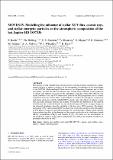MOVES IV. Modelling the influence of stellar XUV-flux, cosmic rays, and stellar energetic particles on the atmospheric composition of the hot Jupiter HD 189733b
Abstract
Hot Jupiters provide valuable natural laboratories for studying potential contributions of high-energy radiation to prebiotic synthesis in the atmospheres of exoplanets. In this fourth paper of the MOVES (Multiwavelength Observations of an eVaporating Exoplanet and its Star) programme, we study the effect of different types of high-energy radiation on the production of organic and prebiotic molecules in the atmosphere of the hot Jupiter HD 189733b. Our model combines X-ray and UV observations from the MOVES programme and 3D climate simulations from the 3D Met Office Unified Model to simulate the atmospheric composition and kinetic chemistry with the STAND2019 network. Also, the effects of galactic cosmic rays and stellar energetic particles are included. We find that the differences in the radiation field between the irradiated dayside and the shadowed nightside lead to stronger changes in the chemical abundances than the variability of the host star's XUV emission. We identify ammonium (NH4+) and oxonium (H3O+) as fingerprint ions for the ionization of the atmosphere by both galactic cosmic rays and stellar particles. All considered types of high-energy radiation have an enhancing effect on the abundance of key organic molecules such as hydrogen cyanide (HCN), formaldehyde (CH2O), and ethylene (C2H4). The latter two are intermediates in the production pathway of the amino acid glycine (C2H5NO2) and abundant enough to be potentially detectable by JWST.
Citation
Barth , P , Helling , C , Stueeken , E E , Bourrier , V , Mayne , N , Rimmer , P , Jardine , M M , Vidotto , A , Wheatley , P & Fares , R 2021 , ' MOVES IV. Modelling the influence of stellar XUV-flux, cosmic rays, and stellar energetic particles on the atmospheric composition of the hot Jupiter HD 189733b ' , Monthly Notices of the Royal Astronomical Society , vol. 502 , no. 4 , pp. 6201–6215 . https://doi.org/10.1093/mnras/staa3989
Publication
Monthly Notices of the Royal Astronomical Society
Status
Peer reviewed
ISSN
0035-8711Type
Journal article
Description
Funding: P.B. acknowledges a St Leonard’s Interdisciplinary Doctoral Scholarship from the University of St Andrews. Ch.H. is part of the CHAMELEON MC ITN EJD which received funding from the European Union’s Horizon 2020 research and innovation programme under the Marie Sklodowska-Curie grant agreement number 860470. V.B. acknowledges support by the Swiss National Science Foundation (SNSF) in the frame of the National Centre for Competence in Research “PlanetS”, and has received funding from the European Research Council (ERC) under the European Union’s Horizon 2020 research and innovation programme (project Four Aces; grant agreement No 724427). N.M. is partly supported by a Science and Technology Facilities Council Consolidated Grant (ST/R000395/1). A.A.V. acknowledges funding from the ERC under the European Union’s Horizon 2020 research and innovation programme (grant agreement No 817540, ASTROFLOW). P.W. is supported by an STFC consolidated grant (ST/T000406/1). R.F. acknowledges funding from UAEU startup grant number G00003269.Collections
Items in the St Andrews Research Repository are protected by copyright, with all rights reserved, unless otherwise indicated.

